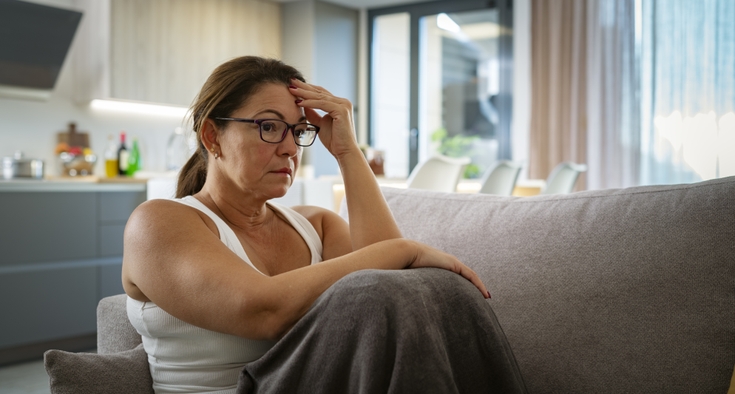
If you’re going through the transition into menopause, you don’t have to just “endure” symptoms like hot flashes, mood swings and vaginal dryness — there are solutions to help you feel more like yourself.
The first thing gynecologist Dr. Claire Bowles of Novant Health Bradford Clinic OB/GYN - Charlotte would tell you: a holistic approach is necessary.
Here are the options Bowles shares with her patients — from lifestyle changes to hormones to medication — and what she doesn’t recommend.
Get complete care for all stages of menopause.
A healthy lifestyle to ease menopause symptoms
Here are a few specific areas that you can address without medication to make menopause easier.
Sleep: ‘You can’t fix the day until you fix the night’
When you sleep, your body rests and digests — both pretty important — but disrupted sleep is one of the most frequent symptoms women deal with during menopause. Poor sleep leads to mood swings, weight gain, memory issues, depression, and a higher risk of heart disease.
I tell patients, “You can't fix the day until you fix the night.” If you can get good sleep, your body works better, your mood gets better, and overall, you will feel better.
How do we get there? Take sleep hygiene seriously. You can’t be “go-go-go” all day and continue that right up until bed; a wind-down routine, a consistent bedtime and wake time, limiting alcohol, and avoiding electronics for at least an hour before bed are all strategies to begin using if you haven’t already.
Improving sleep, especially during perimenopause and menopause, involves a combination of lifestyle changes and if necessary, medications. Supplements such as magnesium can promote relaxation and better sleep, as well as balancing hormones such as estrogen, progesterone and cortisol.
Diet: What to increase … and decrease
I also talk about diet with every single woman going through menopause. I tell them: increase your plant and fiber intake, and decrease alcohol, processed meats and processed foods.
Why? As you transition into menopause, your arteries get thicker and stiffer, you accumulate more belly fat, and your risk for high blood pressure goes up due to hormone changes. All this puts you at a greater risk of heart disease — the leading cause of death for women in the United States.
If you aren’t already eating a heart-healthy diet, it’s time.
Eating the right foods can also help reduce many of the symptoms and side effects associated with menopause. For example, hot flashes can be helped by avoiding alcohol and stabilizing your blood sugar.
Exercise: Walking isn’t enough
As your hormone levels decrease in menopause, you rapidly lose bone density, which can lead to osteopenia or osteoporosis. You also lose muscle mass, which can make you weaker and slow down your metabolism.
Many of my patients are wonderful walkers — which is great! — but in menopause, walking is no longer enough. To slow that bone loss, you also need to perform strength and resistance training at least twice a week, which also helps you maintain (or even gain) muscle mass instead of losing it. Starting strength training is a wonderful way to improve bone density, maintain muscle mass, improve metabolism and support overall health.
Put clearly: If you aren’t strength training, it’s time to start. You don’t need an expensive set of weights; resistance bands, hand weights, or even using your own body weight for resistance can be the way to go.
And keep up that walking and any other weight-bearing exercises such as pickleball, dancing or running, because they also help your bones (and that type of exercise is a critical part of your heart health).
Lifestyle changes work together
The important thing is that all these recommendations complement one another.
For example, choosing high-quality protein sources such as chicken, fish, lentils, or edamame can help you build your muscle mass, and calcium-rich foods like leafy green vegetables can help you maintain bone health. Getting the right amount of exercise will help you sleep better and can improve your mood.
For some women, a healthy lifestyle alone will make symptoms more manageable. Others decide to add medications or hormone replacement therapy on top to get even better results.
Hormone-based therapies for menopause symptoms
Hormone replacement therapy (HRT)
There’s a lot of misinformation out there about HRT. The Women’s Health initiative (WHI study) was one of the most significant, comprehensive research studies on women’s health. However, some parts were misunderstood or misinterpreted.
Early findings showed that combined hormone therapy (estrogen plus progesterone) was associated with increased risk of breast, cancer, heart, disease, stroke and blood clots. These results were generalized to all women, regardless of age, health status or duration since menopause. Later analysis showed that the risk varied significantly based on individualized factors such as age and type of hormone therapy.
For healthy women who are younger than 60 years old and within 10 years of menopause, their personal health history needs to be examined, and in some, the benefits of HRT might outweigh the risk. HRT can help relieve hot flashes and vaginal dryness, improve your sleep and mood, and decrease your risk of osteoporosis, colon cancer and diabetes.
We have learned from the WHI study that the need for personalized approaches to medicine are important, and that a “one-size-fits-all” approach does not serve patients. The treatment decisions for complex issues like perimenopause and menopause and whether or not to take hormone replacement therapy need to be individualized.
For example, we know now that administering estrogen “transdermally" (through the skin) by wearing a transdermal patch, gel or spray can work “systemically” (throughout your body) without the increased risk of blood clot seen with oral estrogen pills. Also, using local vaginal estrogen therapy like a cream applied to the vagina and surrounding tissues can help women with relief of vaginal dryness, decrease pain with intercourse, and improve urinary symptoms associated with menopause.
I explain to patients that HRT is not a cure-all, but my goal is to help alleviate most of their symptoms so they can feel like themselves again. While lifestyle factors like regular exercise and healthy eating remain essential, HRT can provide the energy motivation to make those changes easier. Many describe starting HRT as a transformative experience in managing hormonal imbalances.
There are a few risks of HRT, depending on your personal health history. Come in with an open mind, and talk with your doctor about your individualized risk.
Testosterone
Testosterone can also sometimes be prescribed to postmenopausal women experiencing a significantly low sex drive that is not due to other medical conditions, medications or other life circumstances. In women with hypoactivesexual desire disorder (HSDD), testosterone can sometimes improve sexual desire, arousal and satisfaction.
It’s important to note that there are no testosterone products specifically approved for use in women. As a result, testosterone therapy is often prescribed “off label” using formulations for men at adjusted doses for women. For this reason, testosterone therapy should be carefully considered and monitored closely.
When administered in doses that approximate normal testosterone levels for premenopausal women, testosterone therapy is generally considered safe. There are potential side effects, though, that include acne and excess hair growth, and regular monitoring is recommended. Decisions regarding testosterone therapy should be individualized, looking at the women’s specific symptoms, health profile and personal preference.
Nonhormonal medications for menopause symptoms
Veozah
Best doctors. Amazing nurses. Remarkable care.
As of 2023, there’s a new medication to help moderate-to-severe hot flashes associated with menopause: Veozah. Veozah is a nonhormonal treatment that binds to the receptor in the brain responsible for hot flashes, and helps alleviate them. This is a great option for patients who don’t want to take hormones or who have a contraindication to hormones. Clinical studies demonstrated that Veozah can significantly reduce the number and severity of hot flashes. Some women can experience relief as early as one week into treatment. Many insurance companies do not want to pay for it, but if your doctor thinks it will help you, we can often help you get it covered.
Other medications
We can also prescribe medications to deal with specific symptoms. Some common ones we use for women in menopause include antidepressants, anticonvulsant medications like gabapentin, blood pressure medications and nonhormonal creams to help alleviate vaginal dryness. If you’re having troublesome symptoms, talk to your doctor. We can figure out what options are available.
What isn’t helpful for menopause symptoms: Hormone testing
A lot of times I see patients and they come in with elaborate, very expensive hormone testing they have had elsewhere. During perimenopause and menopause, hormone levels fluctuate significantly, often day to day. A single hormone test may not provide a correct picture of the hormonal status or symptoms. The treatment for menopause symptoms like hot flashes or vaginal dryness often involves a symptom-based approach, rather than targeting a specific hormone level.
Getting your hormones checked — or using an at-home menopause testing kit — is only showing what your hormone levels are at that moment. Your hormones vary day by day and hour by hour. A snapshot isn’t really helpful in understanding menopause; you need the whole picture and history from the patient.
There are times that hormone testing provides useful information, but hormone testing during menopause is generally not considered very helpful.
One step at a time
Sometimes I see patients and menopause has brought them to the doctor for the first time in years. They’re entering menopause running on reserves. We can certainly treat them, but we almost must go back and undo 10 to 15 years of them not putting themselves first.
So I ask: What is one positive step you can take today to make tomorrow easier?
As women, we are balancing so much. It’s hard to prioritize ourselves and our health. But the more you can start to put this stuff into practice, one step at a time, the easier it will be for you to make that transition.
And remember: you aren’t alone. Your doctor is here to work with you and create an individualized plan that helps you get back to being “you” in this new life stage.














